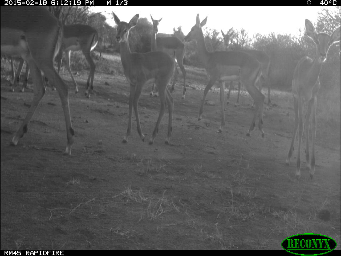Camera traps enable the automatic collection of large quantities of image data. Ecologists all over the world use camera traps to monitor biodiversity and population density of animal species. In order to estimate the abundance and density of species in camera trap data, ecologists need to know not just which species were seen, but also how many of each species were seen. However, because images are taken in motion-triggered bursts to increase the likelihood of capturing the animal(s) of interest, object detection alone is not sufficient as it could lead to over or undercounting. For example, if you get 3 images taken at one frame per second and in the first image you see 3 gazelles, in the second you see 5 gazelles, and in the last you see 4 gazelles, how many total gazelles have you seen? This is more challenging than strictly detecting and categorizing species as it requires reasoning and tracking of individuals across sparse temporal samples.

We have prepared a challenge where the training data and test data are from different cameras spread across the globe. The set of species seen in each camera overlap but are not identical. The challenge is to categorize species and count the number of individuals across image bursts. To explore multimodal solutions, we allow competitors to train on the following data: (i) our camera trap training set (data provided by WCS), (ii) iNaturalist 2017-2019 data, and (iii) multispectral imagery (from Landsat 8) for each of the camera trap locations. On the competition GitHub page we provide the multispectral data, a taxonomy file mapping our classes into the iNat taxonomy, a subset of iNat data mapped into our class set, and a camera trap detection model (the MegaDetector) along with the corresponding detections.
This is an FGVCx competition as part of the FGVC8 workshop at CVPR 2021 and is sponsored by Microsoft AI for Earth and Wildlife Insights. There is a GitHub page for the competition here. Please open an issue if you have questions or problems with the dataset.
You can find the iWildCam 2018 Competition here, the iWildCam 2019 Competition here, and the iWildCam 2020 Competition here.
Acknowledgements
We would like to acknowledge WCS for providing the camera trap data, Centaur Labs for generously providing count annotations on the test data, and Microsoft AI4Earth for hosting our external datasets on Azure.
Kaggle is excited to partner with research groups to push forward the frontier of machine learning. Research competitions make use of Kaggle's platform and experience but are largely organized by the research group's data science team. Any questions or concerns regarding the competition data, quality, or topic will be addressed by them.


Add the first post in this thread.